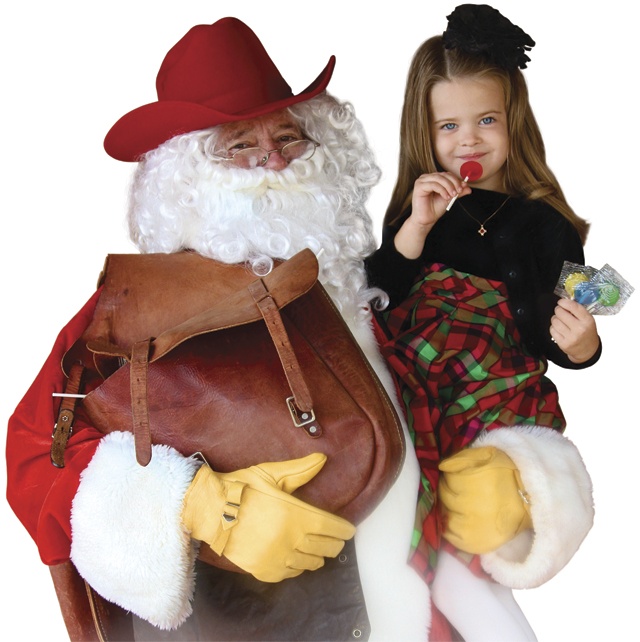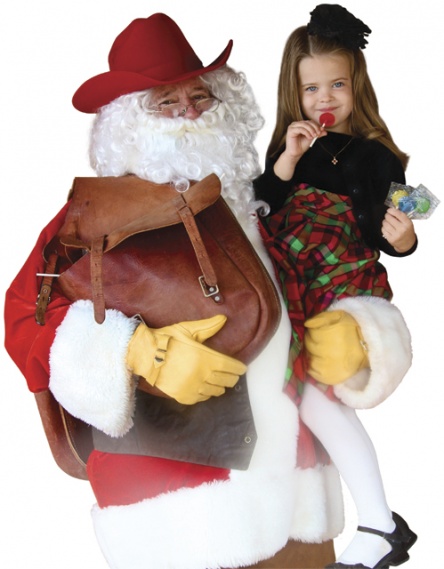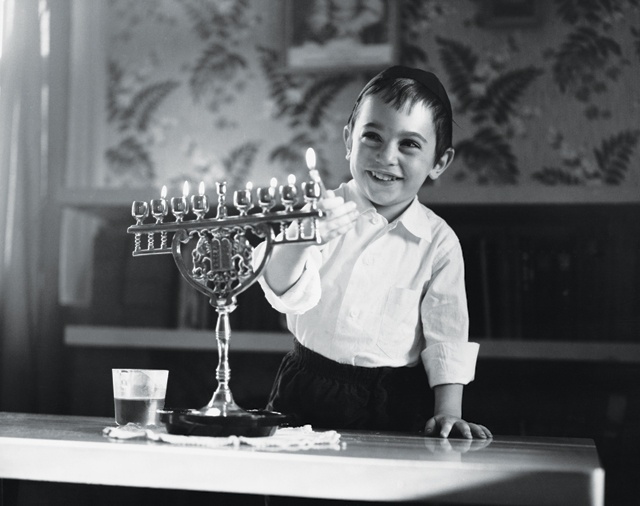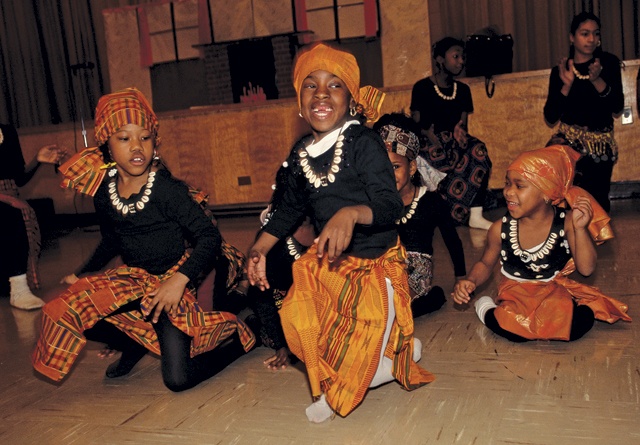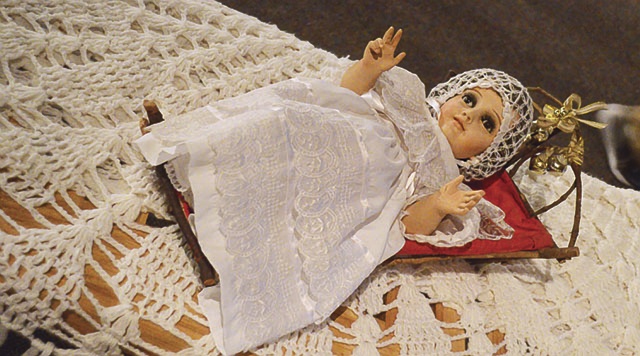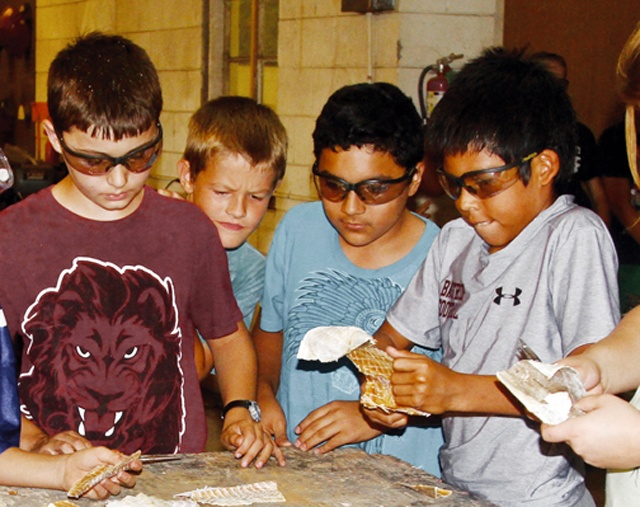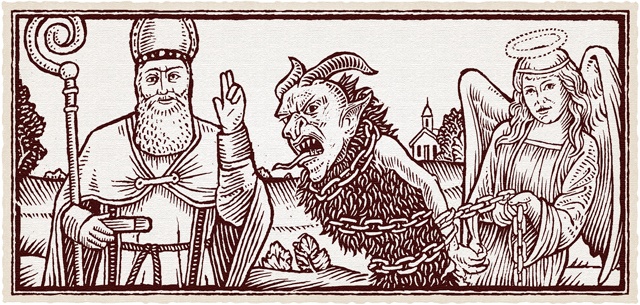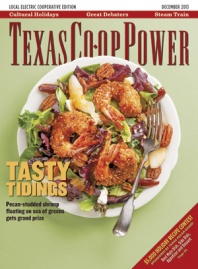Near the tip-top of Texas, where swirling snowstorms conjure up visions of the North Pole, Santa rides shotgun in a pickup pulling a flatbed trailer.
Each December, a few days before Christmas, Texline Mayor Jim Smith dons a red Santa Claus suit complete with East German guard boots ordered from an army surplus store and a leather belt sporting a saddle-cinch buckle.
As Santa for Texline’s Angel Tree program, Smith delivers presents to children in need in this small town served by Rita Blanca Electric Cooperative. His wig and fake beard cover much of his face, making it hard for him to see, so Smith enlists a driver for a magical night’s work on the Texas-New Mexico border 7 miles from Oklahoma. At home after home, Smith grabs wrapped presents off the trailer, knocks on front doors and greets wide-eyed youngsters with a booming “Merrrry Christmas!”
From his red Santa hat down to the faux white fur lining his boot tops, Smith looks like the real thing. And with the suit’s belly pad bulking up his 6-foot-2-inch, 245-pound frame, “I’m plenty fat,” Smith says.
One year, a boy wasn’t home when Smith came calling. Later that night, after his Santa rounds were completed, Smith and his wife, Pamela, saw the boy at a restaurant. When Pamela told the lad that Santa had dropped his gifts off at their house for safekeeping, he incredulously sputtered that he had just seen Santa at school the day before. Why hadn’t Santa handed over the goods then?
Texline’s youngsters see Smith year-round, but most of them never seem to recognize him as Santa. Wonderful, says the 66-year-old Smith: “I want ’em to believe.”
And from the Panhandle to the South Texas border, we do. Granted, as Texans representing many different cultures, we might not all believe the same thing. But during this special time of year when myriad faiths, ethnicities and community events share space on jam-packed calendars, we can honor the heritages from whence we came: African. Asian. Czech. Danish. German. Irish. Lebanese. Mexican. Norwegian. Polish. Spanish. Wendish.
During this Christmas season, which much of the state celebrates, we can embrace diversity. Those of Judaic faith, for example, ask us to understand that Hanukkah, an eight-day holiday that ends December 5 this year, is not the Jewish Christmas. The holiday begins on the 25th day of Kislev on the Hebrew calendar, which can fall at any time from late November through late December. Hanukkah, which means “dedication” in Hebrew, commemorates the rededication of the Temple of Jerusalem in 165 BC after it was defiled. The rededication required that the menorah, or candelabra, be lit. There was only enough oil to burn for one day, but miraculously, the oil lasted eight days. As part of traditional Hanukkah celebrations, Jewish families light candles in a menorah: One of eight candles is lit each night with a ninth candle called a shamash, or helper.
And the members of the African-American community staging big events in Dallas and Houston invite fellow Texans to experience a nonreligious, cultural holiday called Kwanzaa. Its name is derived from the phrase matunda ya kwanza, which means “first fruits” in Swahili, the most widely spoken African language. Kwanzaa, which represents all of Africa as a Pan-African holiday, celebrates family and community. Kwanzaa’s seven principles of unity, self-determination, collective work and responsibility, cooperative economics, purpose, creativity, and faith sound a lot like those by which electric cooperatives abide.
Even if we’re too old to believe in Santa, we can celebrate his giving spirit. Sure, it gets a little weird when inflatable elves and reindeer share front yards with Nativity scenes. But before we charge anyone with sacrilege, consider that the modern-day Santa’s roots date back to St. Nicholas, a fourth-century bishop in a region that’s now part of Turkey who dedicated his life to serving God, protecting children and helping the sick and poor.
As bighearted Texans, we can follow suit. We can give of our time, our money and our love. And as adventurous Texans, we could sample something new this Christmas and holiday season, such as a Spanish-origin folk drama. Or we could be really daring and try a Norwegian delicacy called lutefisk: lye-soaked codfish.
Shepherds of History
In missions, churches, neighborhoods and backyards across Texas, Mexican-Americans re-enact two Christmas folk plays that Spanish missionaries brought to the New World: Las Posadas, a processional drama that re-enacts Mary and Joseph’s search for a posada, or inn, on the eve of Jesus’ birth; and Los Pastores, an elaborate Nativity drama performed in Spanish starring the pastores, or shepherds, alongside masked and costumed angels and devils.
There’s no more appropriate setting than San Antonio, which arose from the establishment of Spanish missions almost 300 years ago, to watch both annual performances. La Gran Posada, considered Texas’ oldest version of this drama, winds its way through downtown San Antonio to historic San Fernando Cathedral. Participants and tourists who join the procession follow costumed actors to the church, where festivities include a mariachi band and choir performance. San Fernando Cathedral first staged the play in 1731, when the church was founded.
About 5 miles south, Los Pastores performances are held yearly at Mission San José at San Antonio Missions National Historical Park. Performed outdoors by members of Our Lady of Guadalupe Catholic Church, Los Pastores is more than a play: It’s a ministry of telling the story of Christ’s birth via a rich, ancient tradition, says 42-year-old Deborah Covarrubia-Barcenez, a cast member since the age of 6. She portrays Tebano, a lead shepherd role she inherited from her grandfather, who now plays the hermit.
Stuffed to the Gills
Every October, Cranfills Gap native Ruth Taylor orders 75 to 100 pounds of codfish from Olsen Fish Company of Minneapolis. The dried fish, which doesn’t require ice for travel—but does carry a distinct odor—arrives around Halloween in cardboard boxes at the Cranfills Gap school. “The UPS man is always glad to get that off the truck,” Taylor says.
From that point on, it’s all hands on deck in preparation for the Cranfills Gap Lutefisk Dinner, a December fundraiser for the school district and a feast that celebrates the Norwegian heritage of this Central Texas town northwest of Waco served by United Cooperative Services.
The codfish arrives almost as hard as a rock—like jerky, Taylor says—and in long fish sticks, which the high school agriculture teacher cuts into 3-inch pieces with an electric band saw. After ag students pull the skin off with pliers, the fish goes into a 30-gallon water trough for three weeks of soaking and rinsing in cold-water mixtures of lye, lime and then a long bath of cold, fresh water under the twice-daily supervision of a fish master. The final step of boiling the fish in salted water completes its transformation to opaque lutefisk: codfish (fisk) preserved in lye (lut).
Overcooked lutefisk turns gelatinous, says the 55-year-old Taylor, who helps organize the annual event. But just like the lutefisk she grew up eating in her grandparents’ kitchens, the firm and flaky lutefisk produced by Cranfills Gap’s experienced cooks is quite good, Taylor says. What does it taste like? She thinks for a few seconds, then laughs: “It tastes like lutefisk.”
Beyond the taste, Taylor says, what really matters is the tradition of eating a fish so rich in history. Pre-Christmas lutefisk dinners trace their roots to the centuries-old Norwegian practice of fasting during the Advent season, a time of preparation for celebrating the birth of Christ. During the Catholic Middle Ages, from roughly 1000 through the early 1500s, codfish was dried outdoors on wooden racks, then soaked in lye, rinsed in fresh water, and boiled and served with butter as part of a fasting ritual.
In modern times, lutefisk pairs nicely with the rest of the Cranfills Gap dinner’s menu: boiled potatoes, white sauce and melted butter, turkey and cornbread dressing, green beans, homemade bread, cranberry sauce and homemade pies.
The dinner, which can feed 800 people, is a community affair. In roles that Taylor once filled, elementary-school students wearing traditional costumes perform Norwegian dances for people waiting to be seated in the high school gym. Older students serve the meal and handle a host of other details, from filling breadbaskets to directing parking-lot traffic.
He Knows If You’ve Been Bad or Good …
Decades ago, Texas children raised in Czech homes didn’t look to the night sky for Santa’s sleigh. They knew that St. Nicholas was coming to the front door with the devil in tow.
Jerry Janecka, an 81-year-old docent at the Institute of Texan Cultures in San Antonio, recalls his earliest memory of St. Nicholas visiting his family’s Central Texas farm in Dubina, the first Czech settlement in Texas.
On December 5, the eve of St. Nicholas Day, the door swung open and there stood three figures: St. Nicholas, the devil and an angel leading the devil by his rattling chains. St. Nicholas, speaking in Czech, asked Janecka, who was 5 or 6, and two younger brothers if they’d been good that year. Don’t lie, St. Nicholas warned: The devil’s right here. He bravely responded in Czech, the only language he knew: Ano. Yes. They’d been well-behaved.
“I’ve never forgot it,” says Janecka, who later learned that an uncle and two neighbors played the imposing trio. “It scared the living daylights out of us.”
But Christmas, resplendent in its simplicities, was a joyful time for the family. Apples, popcorn and lit candles decorated a cedar tree cut and hauled home on Christmas Eve. The family fasted before Christmas Eve midnight Mass and then came home to desserts—kolache, molasses cookies, poppy-seed strudel—and presents. Christmas Day brought a feast of sausage, duck or goose, and gravy and potatoes at Grandpa’s house, who gave each of the grandkids a silver dollar.
Dancin’ in Anson
Inside Anson’s Pioneer Hall, the rules are clear: No drinking. No smoking. And no hats worn while dancing.
Yes, dancing, that controversial, boot-scootin’ activity that from 1933 to 1987 was illegal by ordinance in Anson, near Abilene. The historic Texas Cowboys’ Christmas Ball—first held in 1885 and resurrected in 1934—became an annual event while other dances were banned. Today, all public dances in Anson, the ball at Pioneer Hall included, require a $25 dance permit.
True to pioneer traditions, the Texas Cowboys’ Christmas Ball keeps pertinent rules in play: Men must check their hats at the door, and women must wear a dress (organizers keep extra skirts in the back room). “If you break those rules,” says Suanne Holtman, secretary and treasurer of the Texas Cowboys’ Christmas Ball Association, “it becomes just another dance.”
That’s hard to imagine. This storied ball attracts out-of-state and international visitors and one very special guest: a Western Santa who slips in the front door on the final of three nights before the little ones fall asleep. Wearing a cowboy hat (he’s exempt from the rule), a red coat, Wranglers, chaps and spurs, and toting saddlebags filled with candy, Santa enters ringing bells and shouting out a hearty West Texas “Ho, ho, ho!”
It’s the Christmas and holiday season in Texas: a time to exchange, and appreciate, the cultural gifts that represent our diverse paths. It’s a time for faith, family, community, time-honored traditions, new experiences—lutefisk, anyone?—and, above all, love.
——————–
Camille Wheeler is an Austin writer.
Worth Seeing and Doing in 2013
A sampling of the religious, cultural and community-based offerings around Texas this holiday season:
- November 27–December 31, Wonderland of Lights Festival. Granddaddy of Texas’ Christmas lighting festivals, Marshall.
- November 29–January 1, Texas Hill Country Regional Christmas Lighting Trail. Bandera, Blanco, Boerne, Burnet, Dripping Springs, Fredericksburg, Johnson City, Kerrville, Marble Falls and Wimberley create a luminous trail.
- December 4–22, Ford Holiday River Boat Caroling. Choral and folk groups, bell choirs and Latino ensembles ring and sing on boats along the San Antonio River Walk.
- December 6–7, Native Arts and Crafts Fair. Handmade items from members of the Alabama-Coushatta and other Native American tribes, Livingston.
- December 6–8, Christmas at Old Fort Concho. Shopping, living history, children’s workshops and much more on historic fort grounds, San Angelo.
- December 6–8, 13–15, 20–22, Fiesta de las Luminarias. Centuries-old tradition lines San Antonio River Walk with thousands of luminarias to symbolically light the way for the holy family.
- December 7, Cranfills Gap Lutefisk Dinner. All the Norwegian lutefisk you can eat. Seating times at 4 p.m., 4:45 p.m., 5:30 p.m. and 6:15 p.m. (254) 597-2406 or (254) 597-2505
- December 7–8, Dickens on the Strand. Victorian Christmas festival celebrates 40th anniversary, Galveston.
- December 14–15, KwanzaaFest. Celebrate African-American heritage of family, community and culture, Fair Park, Dallas.
- December 15, La Gran Posada. Re-enactment of Mary and Joseph’s search for lodging on the eve of Jesus’ birth. Evening procession through downtown San Antonio, ending at San Fernando Cathedral.
- December 19–21, The Texas Cowboys’ Christmas Ball. For the 79th consecutive year, they’re dancin’ in Anson.
- December 21, 7 p.m., Los Pastores. Folk play depicts the shepherds’ journey to worship the Christ child and the obstacles the devil puts before them. Mission San José, San Antonio Missions National Historical Park.
- December 26–January 1, Celebrate Kwanzaa. Various venues, Houston.
- German Christmas Pyramid—Carousel-like wooden structure handcrafted in Germany will remain illuminated through the first week of January in Fredericksburg’s Marktplatz.
